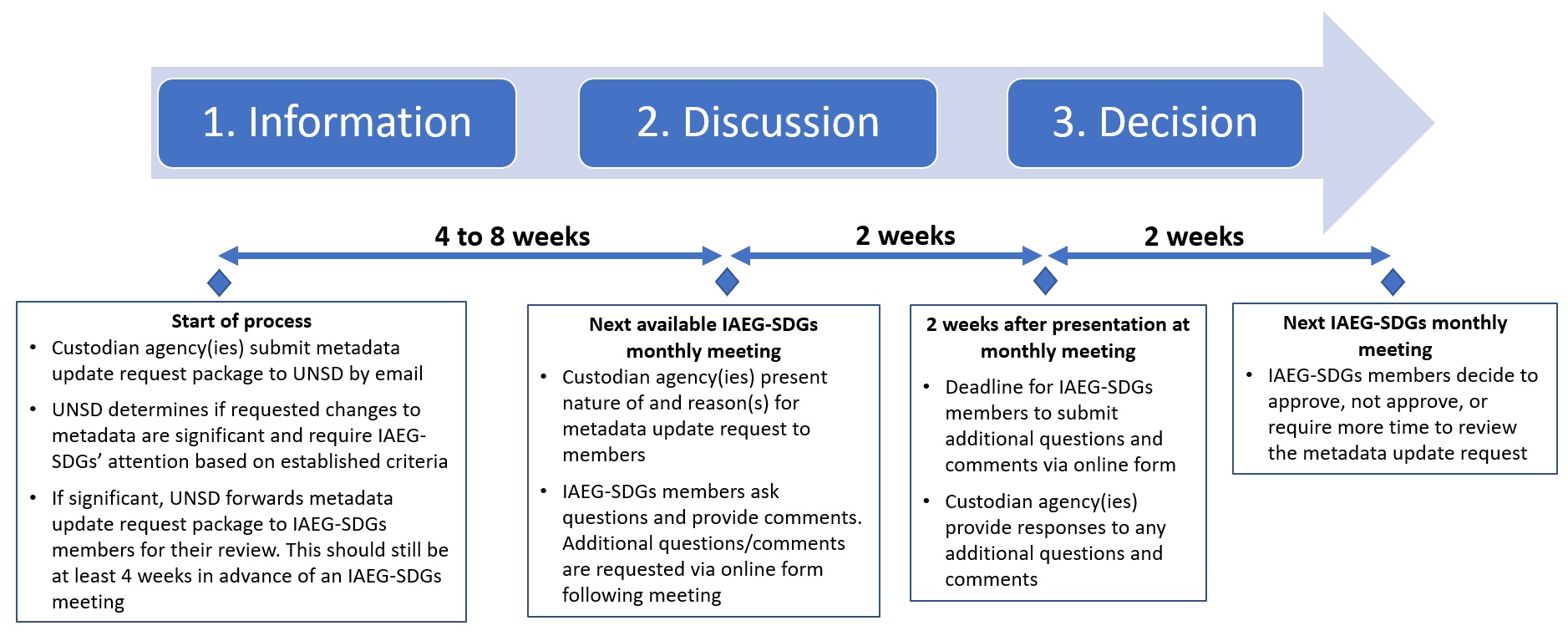SDG Indicators
Metadata repository
The metadata available in this repository is a work in progress. It reflects the latest reference metadata information provided by the UN System and other international organizations on data and statistics for the Tier I and II indicators in the global indicator framework. This repository will be further updated and periodically reviewed in cooperation with the respective data compilers.
In addition:
- Official list of Global Sustainable Development Goal indicators
- Tier Classification for Global SDG Indicators
- Previous Work Plans for Tier III Indicators (archive)
- Metadata for initially proposed indicators (archive)
Metadata update process:
Methodology for indicators is expected to update from time to time. For any metadata updates that include significant changes (detailed in the form below), the IAEG-SDGs will review the changes during its member meetings based on the update request form (see below) and track change metadata provided. Custodian agencies will also be invited to attend an upcoming IAEG-SDG member meeting to present on the proposed changes and answer any questions.
As requested by the IAEG-SDGs, custodian agencies must provide their metadata update request documents at least one month in advance of their next scheduled meeting to allow for sufficient time for review. Depending on the time of submission and the next IAEG-SDG member meeting, the timeline for review and approval can span up to 12 weeks or more. Therefore, it is important to provide submissions as soon as they are available. Please note that no data are published in the Global SDG Indicators Database until the corresponding metadata is approved by the IAEG-SDGs.
Please see below the projected stages and timeline.
To get started, custodian agencies are requested to:
- Download the metadata Word file for the indicator from the metadata repository (below) and edit the Word file in track changes to show the requested changes.
- Custodian agency downloads and completes the “Metadata update request form” (below) and sends the request package to sdgindicators@un.org.
Search
Goal 8. Promote sustained, inclusive and sustainable economic growth, full and productive employment and decent work for all
Target 8.1: Sustain per capita economic growth in accordance with national circumstances and, in particular, at least 7 per cent gross domestic product growth per annum in the least developed countries
Target 8.2: Achieve higher levels of economic productivity through diversification, technological upgrading and innovation, including through a focus on high-value added and labour-intensive sectors
Target 8.3: Promote development-oriented policies that support productive activities, decent job creation, entrepreneurship, creativity and innovation, and encourage the formalization and growth of micro-, small- and medium-sized enterprises, including through access to financial services
- Indicator 8.3.1: Proportion of informal employment in total employment, by sector and sex
Target 8.4: Improve progressively, through 2030, global resource efficiency in consumption and production and endeavour to decouple economic growth from environmental degradation, in accordance with the 10‑Year Framework of Programmes on Sustainable Consumption and Production, with developed countries taking the lead
- Indicator 8.4.1: Material footprint, material footprint per capita, and material footprint per GDP
- Indicator 8.4.2: Domestic material consumption, domestic material consumption per capita, and domestic material consumption per GDP
Target 8.5: By 2030, achieve full and productive employment and decent work for all women and men, including for young people and persons with disabilities, and equal pay for work of equal value
- Indicator 8.5.1: Average hourly earnings of employees, by sex, age, occupation and persons with disabilities
- Indicator 8.5.2: Unemployment rate, by sex, age and persons with disabilities
Target 8.6: By 2020, substantially reduce the proportion of youth not in employment, education or training
- Indicator 8.6.1: Proportion of youth (aged 15–24 years) not in education, employment or training
Target 8.7: Take immediate and effective measures to eradicate forced labour, end modern slavery and human trafficking and secure the prohibition and elimination of the worst forms of child labour, including recruitment and use of child soldiers, and by 2025 end child labour in all its forms
- Indicator 8.7.1: Proportion and number of children aged 5–17 years engaged in child labour, by sex and age
Target 8.8: Protect labour rights and promote safe and secure working environments for all workers, including migrant workers, in particular women migrants, and those in precarious employment
- Indicator 8.8.1: Fatal and non-fatal occupational injuries per 100,000 workers, by sex and migrant status
- Indicator 8.8.2: Level of national compliance with labour rights (freedom of association and collective bargaining) based on International Labour Organization (ILO) textual sources and national legislation, by sex and migrant status
Target 8.9: By 2030, devise and implement policies to promote sustainable tourism that creates jobs and promotes local culture and products
- Indicator 8.9.1: Tourism direct GDP as a proportion of total GDP and in growth rate
- Indicator 8.9.2: Employed persons in the tourism industries
Target 8.10: Strengthen the capacity of domestic financial institutions to encourage and expand access to banking, insurance and financial services for all
- Indicator 8.10.1: (a) Number of commercial bank branches per 100,000 adults and (b) number of automated teller machines (ATMs) per 100,000 adults
- Indicator 8.10.2: Proportion of adults (15 years and older) with an account at a bank or other financial institution or with a mobile-money-service provider
